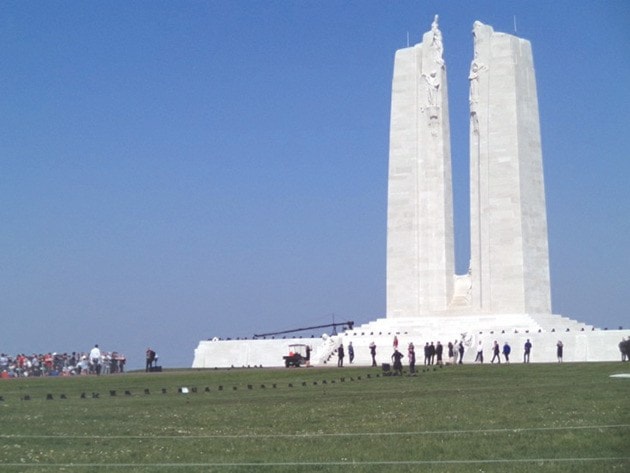The people in our tour group had a variety of reasons for travelling to Vimy for the 100th anniversary. Some were there to remember relatives who fell in the battle. Others, who had visited before, wanted to add the significance and solemnity of the moment to their memories and understanding of the site. And some, like myself, simply took this opportunity to visit a site we had heard so much about. I think we all, as well, wanted to share a moment of history with others and recognize and honour those who fought and those who died.
Unfortunately, the event itself did not live up to expectations: hours of standing in line in an open parking lot to board shuttles to the monument, followed by hours more of standing in the hot sun before and during the ceremony, and then a few more hours in a mad crush waiting to re-board the shuttles. There was very little seating, virtually no shade, one water station, and ten porta-potties for tens of thousands of people. I wish I could say that the ceremony itself made up for it, but no one in our group managed to see or hear anything. What should have been powerful, emotional, moving, a fitting recognition of Canada’s brilliant success in the battle a century ago and a symbolic coming-together anew of the nation - turned out to be merely gruelling and disappointing.
Nevertheless, there were some poignant and touching moments. The veterans in the crowd were continuously thanked by younger people, many of whom had tears in their eyes. An army officer with the Seaforth Highlanders had walked across the battlefield that the predecessors of the regiment crossed a century ago. “It was literally walking in the footsteps of history,” he told me. “I got chills down my spine.”
Prior to the ceremony, the names of all those who fell at Vimy Ridge were read aloud. You really begin to appreciate what “3,600 men” truly means when you learn how long it takes to read out all those names.
The hush that fell over the crowd when the First Nations drummers performed, when the 21-gun salute was fired, and again when the biplanes flew overhead, was very moving. You could hear a pin drop when the Last Post was played, according to one member of our group who was able to hear that.
The contribution of the Canadians in the Great War is still clearly appreciated by the French population: as we drove through the town of Vimy, streets and houses were decorated with Canadian flags and bunting. People were standing out in their yards, waving, all along the route, but the one that touched me most was the little girl, balancing atop a wall with the help of her mother, waving for all she was worth.
And, perhaps most gratifying of all, was the number of young people in the crowd. There were (seemingly) millions of high school students, many groups of air, army, and navy cadets, children travelling with parents and grandparents. We worry that the significance of the Great War is being lost, that the younger generations are losing an appreciation of the sacrifices of their forefathers, but the reverence shown by many of these young people - despite the shortcomings of the day - suggests that perhaps our collective remembrance is in good hands.
